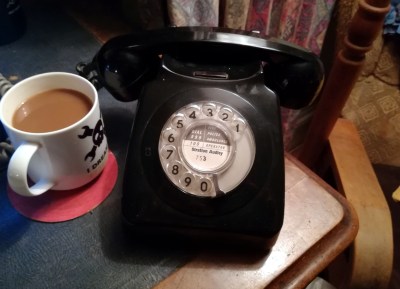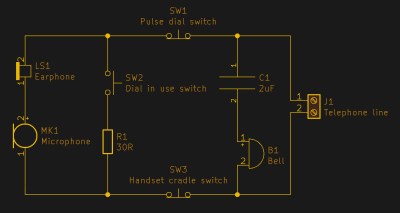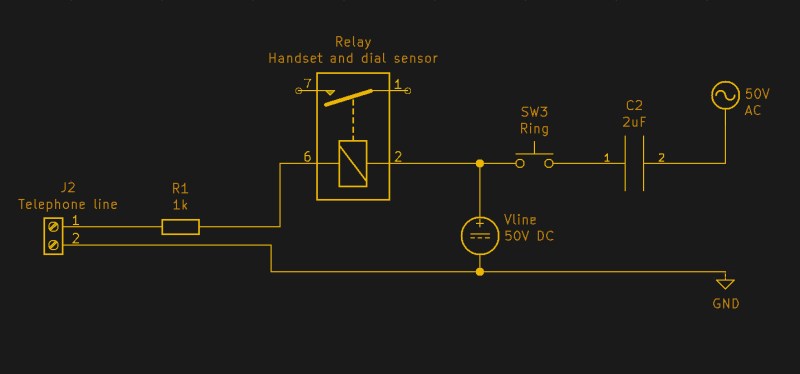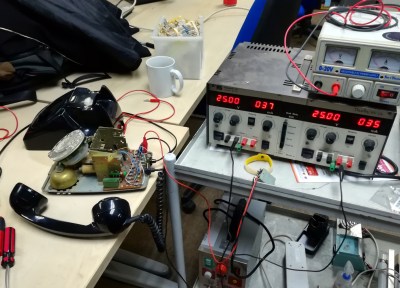When we make a telephone call in 2020 it is most likely to be made using a smartphone over a cellular or IP-based connection rather than a traditional instrument on a pair of copper wires to an exchange. As we move inexorably towards a wireless world in which the telephone line serves only as a vehicle for broadband Internet, it’s easy to forget the last hundred years or more of telephone technology that led up to the present.

In a manner of speaking though, your telephone wall socket hasn’t forgotten. If you like old phones, you can still have one, and picture yourself in a 1950s movie as you twirl the handset cord round your finger while you speak.
As we move inexorably forward, it’s worth considering for how much longer we’ll be able to do this. If all goes well, I’ll be receiving a new fibre optic connection in a few weeks. Along a sliver of glass will come faster Internet that I can currently dream of, and I’m expecting that the box that our telephone provider puts on the end of it will have a telephone socket that is simply the front-end of a dedicated VOIP client. It’ll undoubtedly work with my digital answerphone, but will it still work with a 50-year old model with an old-fashioned dial designed for use with a mechanical Strowger exchange? If I’m going to have to hack on this old phone, I’d better figure it out now in case I have to hook it up to something else to keep it communicating.
Just How Does A Telephone Work?

The great thing about a passive device whose roots lie around the turn of the twentieth century is that its principles are relatively easy to understand. A phone like my GPO 746 contains a lot of clever circuitry to give it better audio, and to protect it from line faults, over-voltage, and other mishaps. But its most basic operation can be explained with something like the much-simplified schematic we’ve pictured.
On the left is the handset, with a carbon microphone and an earpiece in series. When the handset is off the cradle, SW3 is closed, and because the line has a standing DC voltage on it a current flows through the handset. Any audio on the line is heard in the earpiece, and any speech into the carbon microphone varies that current and creates an audio signal in return.
![A telephone dial, front and rear. Daderot [CC0]](https://hackaday.com/wp-content/uploads/2019/12/1024px-Automatic_Electric_821C_rotary_dial_-_Telephone_Museum_-_Waltham_Massachusetts_-_DSC08171.jpg?w=400)
SW1 and SW2 are the contacts in the dial, and since it has become a viral meme that people below a certain age may be unfamiliar with dial phones it’s worth explaining the operation of the dial for them. A spring loaded disk is rotated to a point representing the desired number by the user before being let go. It returns at a constant rate set by a governor, and as it does so it closes a set of contacts here labelled SW2 to switch in a low resistance across the handset, and it passes its other contacts, SW1, over a toothed wheel. The effect is to interrupt the line current and create a series of pulses set by the number dialed, which were originally used in a mechanical exchange to advance the switchgear a step with each pulse.
An interesting side-effect of this circuit is that with some telephones it was possible to simulate dialing by rapidly depressing the cradle in sequence. On some payphones this offered a means to circumvent the coinbox circuit which disabled the dial. (I remember some students at my university getting into trouble for doing this.) Who needs a 2600 Hz tone to scam the telco!
The Other Side Of The Socket
Having understood our telephone, how might we simulate a telephone line to connect it to? I sat down for an evening in the hackerspace with my GPO 746 to find out.

A web search will tell you that a phone line carries a standing DC voltage and an intermittent AC voltage to operate the bell. Further searching reveals that each of those voltages can be 50 V, and that the DC current shouldn’t be more than 50 mA. A good place to start therefore is with a bench power supply set to 50 V, and a 1 kΩ resistor to limit the current and simulate the resistance of several miles of phone cable. With the resistor in place any change to the line can only cause a 50 mA current to flow, and thus the possibility for damage is reduced. Connecting this to the 746 resulted in the sound picked up in the microphone being audible in the earpiece, and had I wanted to I could have retrieved the audio after the 1 kΩ resistor.

Similarly, with the handset on the cradle I could apply an AC voltage and ring the bell. My AC transformer was a bit less than 50 V, but it did work with smaller volume. I still lacked any means of sensing dialing or the cradle, for which I needed to sense the presence or absence of 50 mA DC current. The real GPO exchange back in the day would have done this with a relay in series with the line, so I reached for a small relay. At this point I learned that relays have a hysteresis curve on their close and release currents so it was not as reliable or as quick as I’d hoped. I began to understand why telecoms circuits use reed relays. In the future I’ll have to use a current sensing resistor and a transistor to do the job.
To make this work as a real project, I will have to pay attention to my two 50 V power supplies with probably a little boost converter and oscillator to produce my AC bell drive, and then I’ll need to program a microcontroller to handle being on-hook and off-hook, as well as decoding the pulse streams into numbers. I may also have to pay attention to the phase relationship between my audio source and the audio from the microphone, as feedback can become a problem in some circumstances. Once I have mastered those things I’ll be able to make a unit that sits behind a standard British Telecom master socket and provides a connection to anything I choose, be it a GSM module or a SIP client on a single board computer. In that way I can still be using my GPO 746 dial phone in decades to come.
















There have been a number of projects to turn an analog phone into a wireless phone (including dial and cradle detection). One project sets up the phone as a bluetooth headset, another does a full-blown integration with cellular SIM-based systems.
https://www.amazon.com/Anley-inch-Functioning-Adult-Decal/dp/B07KC8Y2PS/ref=sr_1_2?keywords=functioning+adult+2020&qid=1579025742&sr=8-2
I considered that, but decided I wanted an unmodified phone, and to provide a wall socket as though I had a British Telecom exchange line.
Jenny, I’m in the same boat, albeit a boat on the other side of the pond. I appreciate this article, and your reasoning. I want to use my 60’s Western Electric phones for as long as I can.
This is an older article, but we have Ooma (VOIP) phone servie so we can maintain our original phone number, which limits the amount of telemarketers that call our cell phones as well (I give this number out). It also means I get to use vintage phones.
Dear Charlie,
Could you tell me the names of the various projects that you mentioned? I want to connect my GPO phone to my iPhone.
Many thanks,
Joe
Try an optocoupler to sense off hook and dial?
Good idea!
Thanks for this thread, Jenny! I have a small collection of *real* phones. Bought a “telephone line simulator” off eBay ($100) to allow me to test them. I have actually done some phone line interfacing for a voice messaging system in a previous life. Nice to see the topic come up again.
For decoding DTMF, the classic chip used to be the Mitel MT8870, but now you can probably do it with an Arduino and some DSP code :-). Good thing they didn’t have those back in the Blue Box days:
https://classic.esquire.com/article/1971/10/1/secrets-of-the-blue-box
Thats how used to be done, with optocouplers.
Actually, other than decoding the dial closures it’s not that complicated. Back in the day they would connect the parts of a phone in a wall box for a ringdown circuit (like a telephone based intercom) with a 12 volt battery for carbon microphone voice and a hand cranked generator for ring voltage to ring all other phones on the circuit. You could generally connect up to a distance of 10 to 20 miles on one of these depending on wire size.
Even though it’s obsolete today, phone technology was pretty interesting in its day.
Indeed. There’s a bit of phasing fun & games to avoid feedback, but that’s it.
What’s called a telephone hybrid network. It consists of 2 transformers that directionally isolate the 2 paths. It is really interesting technology that is shortcut in VoIP phones. Instead of using a hybrid VoIPs use companding and compression which isn’t as good IMHO. Old analog speakerphones sounded surprisingly good when they had low noise lines. Another good education can be had by digging into how they approached engineering analog single sideband long lines, referred to as being able to speak “Debrinco”. Subcarrier groups and supergroups with baseband being inverted. First letters refer to dB and last ones refer to the Bell System weighted frequency response mask referred to as a “C” message.
IIRC, Hackaday did an article about the hybrid circuit (years ago), which is where (I believe) I first learned about it. But I didn’t find it using the HaD “Search” box.
Caleb, are you listening? B^)
As someone who once attempted to design a hybrid with opamps, I’m getting a kick out of this. “a bit of phasing fun and games” is putting it mildly :-)
Sure, it’s theoretically simple: you null out the outgoing audio from the incoming line and there’s your incoming audio. In practice, though, the level and phase of the incoming audio depends on the impedance of the line (nominally 600 ohms resistive), which changes with each call :-)
You can, however, get pretty close. Lots of app notes out there if you search for “hybrid” or “2-wire to 4-wire”
There used to be SLIC (Subscriber Line Interface Cards/Circuits) available back when PBXs were analog. They are probably available from scrap dealers now, already mounted on line cards with serial digital I/O
You can make an path isolating hybrid with five resistors. This method has a much higher insertion loss than transformers but that’s easily fixed with op-amps.
In the UK the telephone uses a third wire for the ring signal, separated from the incoming pair by a capacitor in the master socket.
Indeed, and since my 746 has a BT plug conversion I’ll be using one of those. It takes the 2-wire connection.
Wonderful article.
I have an identical phone (well, the label says Walkerburn rather than Stratton Audley) and it’s in use every day. The ring is priceless and can be heard all through the house and down the garden. To be sure we have a trio of cordless phones too, but they stop working when there is a powercut wheras the old 746 remains fully functional.
They have these things called UPS that you can plug your charger into :-)
Very high quality pieces of kit. I’ll have to experiment with ring frequency to find the resonance of the bell.
Here in the US it was (still is?) 90Vac 20Hz
And you don’t want to be touching the phone lines when it rings, or even when no phones are off hook, for that matter.
Don’t ask how I know…
Germany and probably lots of Europe had (has?) 25Hz
UK ring standard frequency is 16-2/3 Hz (50 Hz divided by 3). Note that the US frequency is 60 Hz divided by 3. The ring voltage can peak at 210 V (from memory, but I cannot remember whether that includes the 50 V exchange battery).
In the u.s. ring voltage is generally 16 to 25 Hertz which was the based on the output of hand operated ringing generators commonly used in early phones particularly rural ones. The 20 hertz normal frequency really has nothing to do with the 60 hertz line frequency of the power grid. in some cases 30 Hertz was used for ringing because it was a 1/2 divided from the 60 hertz power grid, in those cases a ferroresonant transformer was used to produce a sub cycle of 30 Hertz from 60 hertz powerline frequency. frequency selective ringers were sometimes used in Party line situations particularly on automatic exchanges. there are numerous variations on the frequency selective ringer depending on the manufacturer the number of extensions on the line and so forth. I’m pretty certain there are no longer any party line setup in use except perhaps in certain rural areas
I still have my old phone plugged-in to an Obi200. That little box even allows you to program the ring style. Mine is connected to Google Voice through the Internet. The old phones are very comfortable on the ear.
Does that support pulse dialling? I’ve looked at a lot of VOIP boxes but have yet to find one that confirms it supports anything but DTMF.
Sadly, it appears that this device does not support rotary dial phones (https://www.obitalk.com/info/faq/GV-and-the-OBi/gv-inc-n-outgoing.) I also have an old (U.S.-style) rotary phone, and this got my hopes up. Unfortunately, I don’t have the time to design and build my own switch simulator.
dialgizmo as Frank mentions below.
Apparently Grandstream HT502 supports pulse dialing.
(http://www.classicrotaryphones.com/forum/index.php?topic=20386.0)
I have a 1938 model Stromberg Carlson Model 1243 (all metal not bakelite) phone plugged in to Obi200 via a pulse to tone converter from http://www.dialgizmo.com. It works well and is my primary home phone. I needed this when the kids were home alone before they were old enough for mobile phones. I did have to change the ringer to one that rings at a standard frequency (these were commonly used on party lines where everyone had a different ring frequency)
My Motorola box supplied by Vonage supports pulse dialing, but it’s over a decade old.
https://www.oldphoneworks.com/ sells pulse to DTMF converters.
You could have made it easier for yourself by using a Silvertel Ag1171 (https://silvertel.com/ag1171/) (or one of its clones : r-tone ks8035f). You can leave the old rotary phone as is. The module can be directly connected to an MCU (for pulse decoding etc). You no longer have to worry about generating HiV ringing voltages or monitoring loop currents.
Wow. OK, didn’t know those were a thing. Or that they can be had for a few dollars on AliExpress.
To take this a step further, now I know what I’m looking for I found this project on hackaday.io.
https://hackaday.io/project/18871-cellular-conversion-of-vintage-rotary-phone
There’s also QCX601 that is not a direct clone but its block diagram looks suspiciously familiar.
And I guess I should have read the whole thread before responding because the project you mentioned uses QCX601. Oh, well…
I can recommend this: https://www.dialgizmo.com/
Just got one and it works great on my US dial phones.
Also: Notes on the Network and TCI are both valuable sources of information on the (late, lamented) Bell System equipment and network.
TCI: https://www.telephonecollectors.org/
Notes on the Network: https://www.telephonecollectors.org/
http://www.classicrotaryphones.com/forum/index.php
And, if you’re ever in Seattle on a Sunday Morning…https://www.telcomhistory.org/connections-museum-seattle/
“A spring loaded disk is rotated to a point representing the desired number by the user before being let go.”
No. You would put your finger, through the hole on the disk, on the desired number (figure) on the dial, and then rotate the disk clockwise all the way untill your finger is stopped by a little bracket in its way. There, you would pull the finger out of the hole, letting the spring return the disk to its initial position.
I’m describing the operation behind the scenes, not the user experience. Read it again.
That’s the same thing said in a different way. In both cases, the disc is rotated to the extent of the number being dialed, and then released.
I know that you know how it works, but the description pictures it like if there were several marked points on a dial, and user would rotate the disk until some mark on the disk would reach corresponding point.
Yes, obviously they could have made it like that as well, without changing underlying mechanism, but then the feedback would be almost entirely non-tactile, and its usage either slower or misdial prone. In a way, interface design of rotary dial is also very well thought out.
Our system was similar.
DC was 48V. AC was 60V / 50Hz
The line was connected to two relays in the exchange.
One relay was made to be slow release by putting a copper slug on the relay core. Eddie currents would hold the relay on when dialing.
The other was made quick to respond by putting a piece of plastic between the relay core and the armature. This puts an air gap in the magnetic path so the the magnetic field would collapse rapidly so the dial pulses could be detected.
When required the two audio directions were separated with a hybrid transformer. The same can be done with simple resistors. Line impedance was 600 ohms.
48V nominal – buffered by a stack of lead acid batteries. So, depending of their state of charge, something between 40 and 56V. So I see “50V”as a valid representation, could even be up to 60V, if they were fast charging the batteries for any reason or it happens to be cold.
What’s even more interesting are the circuits when telephones operated on local batteries because the switch board was really just a switch board and didn’t (necessarily) supply any power to the phones.
http://telephone.bouwman.com/Magneto-Circuits.html
There was a magneto circuit to provide the ringing voltage with a hand crank, and the local battery was looped through the carbon microphone and a transformer to step up and inject the signal into the line that connected both earpieces in a loop.
I remember the olden days before house phones and you had to queue up to use the only payphone in the parish. Nobody could call you. Great days.
Parish?
Louisiana?
A vintage phone in 2020? What is a top of the line, cutting edge $1000 phone in 2019?
I remember one of the farmhouses I lived in as a child, had a bunch of corroded dry cells hanging between the floorboards (as seen from the basement).
One farmhouse still had a hand crank wall phone, it worked until my cousin accidentally broke the cord that connected the transmitter (earpiece) to the main box. No one in our house (at the time) knew how to fix it. I was 5 years old at the time.
Ahhh, found something in an late 30s basement, kind of a box/cradle of that industrial pressed cardboard (Vulcanised fibre???) between the beams, that looked like it had acid stains on it, near old phone wiring. Thinking now that that maybe had cells of some kind in it.
I have a model 746 I picked up when our ship was Porta called in edinborough. I also have one of those little compact phones with the strangely shaped handsets the model number I cannot remember the moment. Cut my teeth on rotary dial equipment back in the early 70s dot-dot-dot good memories
Trimphone? https://en.wikipedia.org/wiki/Trimphone
I was playing with this but was for other people to play with. A concern was a shock from the AC, I know it’s not lethal, but could be a bit painful? Do you plan on limiting the current into the transformer? Is it as simple as a resistor on the low side of the transformer?
> …could be a bit painful …
Especially if you were up a ladder on a pole at the time!
Once upon a time I had a room without a phone line installed, and the landlord just ran some phone cord off a splitter and gave me bare wires. I was holding the cord in my mouth while getting the plug ready to insert the wires, when it slipped and the wires came in contact with my tongue.
I was rather surprised by the pain of the shock, it was much worse than when I fixed a TV on switch and discovered I was also touching it.
Enclose it in a replica of Mondial House FTW!!!
For those of us who didn’t get the reference…
https://en.wikipedia.org/wiki/Mondial_House
Telephone services on a POTS line versus a VOIP service makes little difference on the home consumer level. The EMTA or other device which give phone service to VOIP or digital phone subscribers converts to pots at the port to continue the ability to use standard un-powered phones. Not all carriers have pulse dial, but the ability to use a rotary phone wont end that soon.
In the U.S., a ‘copper-system’ Central Office contains a very powerful ring-tone generator which generates ≈ 100 vrms (280 v p-p) at 20 Hz, which is used to energize (‘ring’) the old-style high-current bells which still may be in use in, for example, Bell 500 and 2500 hand-sets. This 280 v p-p is added in series with the -48 vdc telephone-system voltage (one reason for the VERY high power ring-tone generator is that ring-tone may be required to be sent to a LOT of telephones at the same time).
This is one reason (but you don’t see it much any more) for the warning by telcos to stay away from downed telephone lines: under the wrong set of circumstances, the Central Office’s sending of a ring-tone could be fatal.
Whenever I work on a residential phone system, I ALWAYS make certain that one telephone is “off-hook”, because the Central Office will not send ring-tone to a telephone which is in use (is “busy”; being “off-hook” is “busy”).
Irregardless of what you thought, telephone system voltages and currents are not benign.
Even VOIP systems push a 90v ring charge. we used to tell rookies trying to backfeed a system to stick the lines in their mouth and call the phone number to find their feed
I think you meant to say ” NOT EVEN A vehicle for broadband Internet..”
For those that need cheap voip solution for these old rotary phones, some voip routers with Lantiq based soc can be flashed with openwrt and asterisk client, with integrated support for pulse dialing.
See: https://openwrt.org/docs/guide-user/services/voip/chan-lantiq
Or google “lantiq chan sip”, “lantiq voip”.
Many of those routers can be found cheaply on ebay/local online marketplaces.
I have two antique telephones. One a candlestick, another 1950’s.
I’d love to get the candlestick and the 1950’s one working on today’s modern network.
Telephone museum in Waltham Mass is very cool. Also the steampunk capital.
Right down the road from me. Thanks for the tip, must visit!
In rural America, they had this thing called a partyline. A number of individual subscribers (multiple houses) were all wired up in parallel on a single phone line which could have been many miles long. Any time a subscriber picks up the phone (and DC loads the line) it would light the indicator at the central office. An operator would see the indicator light and place the outbound call without really knowing which subscriber was making the call other than the caller self identifying. An inbound call to one of the subscribers would be initiated by the central office operator selecting one of the different ring voltage frequencies which would selectively ring only one subscriber’s phone(s). The bell circuits were resonant and responded selectively to only their ring frequency.
It was quite common for rural partyline subscribers to sit in and listen to the other phone conversations from other houses as all subscribers were on the same shared phone line and each phone was an extension of the same single phone line.
To place a phone call you would pick up the phone and wait for an operator and say “operator give me Hillcrest 362” and it would be manually set up. The rotary dial for placing a phone call was a blockbuster breakthrough technology in its time although it put tens of thousands of telephone operators out of work.
Some “party line” subscribers were identified by not the frequency, but the number and length of rings, such as “two short, one long, is (meant for) Brown’s”.
Correct. Resonant selective ringing was a technology breakthrough.
It’s also possible to connect a military Field Telephone, such as an EE-8, to the network (although not really recommended). And, a friend discovered that, by tapping the hook-switch at a regular/rapid rate, he could effect dialing out on such a phone. Now, this was in the 1970s, and was a bit of a desperation move so that he could have a telephone in his bedroom. But, sometimes, desperation is the father of inventions. :-)
Dave:
In the 80’s I desperately needed to make a call on a pay phone (remember those?) in Cameron Parish on the only phone I could find for miles on a mom and pop phone company. The touchtone buttons were dead. I flipped the handset hang-up switch 10 times and got the operator who manually placed a collect call.
That’s fantastic.
I used to be a phone service tech so I’d find lots of phones with faulty dials.
My office staff number was 921 111 so once you got the 9 the rest was easy.